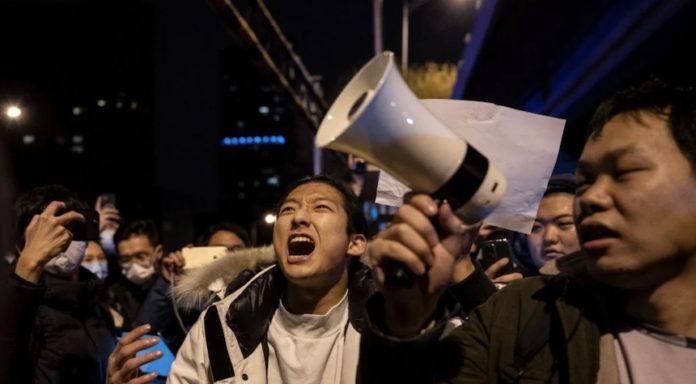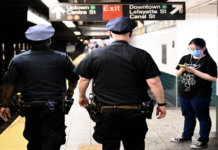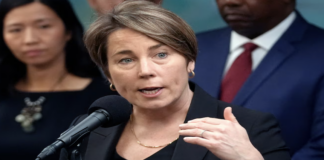Protests against the communist Chinese dictator Xi Jinping, and his regime’s draconian COVID-19 protocol, erupted in China over the weekend in what was called the “White Paper Revolution.” This is the largest uprising since 1989 when thousands of Chinese were killed by the communist regime in the Tiananmen Square protests.
Massive protests broke out in Shanghai, Beijing, and other Chinese cities, condemning the communist regime’s “zero COVID” policies. Chinese police reportedly arrested some protestors, pepper-sprayed thousands, and tried to stop demonstrations under the authoritarian surveillance state.
According to The Daily Mail, protesters in Shanghai demanded that the regime lift the lockdown in Urumqi and Xinjiang, as well as lift the lockdown throughout China.
Protesters demanded that Xi Jinping, the Chinese dictator, resign as well as the CCP’s resignation. They said, “Xi Jinping Step Down!” “CCP Step Down!”
“Traitor #XiJinping! #XiJinping, step down! Dictatorial Government, step down! F*ck…”
Crowds shouting while they gathered at #Urumqi Road in #Shanghai city today to protest against the #CCP’s #ZeroCovid #lockdown. pic.twitter.com/lDvwCdlzyS— Jennifer Zeng 曾錚 (@jenniferzeng97) November 27, 2022
One protester in Chongqing was attempted by police to be taken away. He declared that he would prefer death to freedom.
Newsweek reports that protestors have taken to the streets with blank white paper sheets to symbolize and decry the Chinese regime’s censoriousness. This movement has been called the “White Paper Revolution” (or the “A4 Revolution”) by many.
According to reports, a video of a woman from the Communication University of Nanjing holding a piece of paper was viral. Another person quickly took it away.
One translation of the tweet stated that “Even if they hold up a blank piece of paper, it makes them afraid.” It is not the power that blank sheets of paper have, but it is the power to awaken. It is because nothing is written …”.
即使举起一张白纸,也让它们恐惧,不是白纸的力量,而是觉醒的力量,因为,正是因为什么都没有写,所以才什么都写了…… pic.twitter.com/4ENCpKUfQP
— 李 庆 (@LQ0068) November 26, 2022
CNN has previously highlighted how open defiance of regimes is “extremely rare,”, especially in countries where dissidents or perceived foes are imprisoned and tortured, enslaved, and, in some cases, thrown into concentration camps.
After three years of COVID-19 policy and decades of murderous authoritarianism, the spark that ignited the Chinese protests was a fire.
According to reports, the new lockdowns were caused by a rise in COVID-19 infection rates. An estimated 40,000 people are currently infected each day (in a country with over 1.4 billion inhabitants).
The regime is building new detention camps in certain parts of the country for the infected. For example, a new Guangzhou camp will be able to accommodate and isolate almost 250,000 people accused of COVID-19.
For the second day in a row, China has recorded an explosive increase in coronavirus infections.
In the city of Guangzhou, the capital of Guangdong province, which has the largest number of cases, the construction of a quarantine center for 80,000 people has begun. pic.twitter.com/LnOZdVdVjO
— NEXTA (@nexta_tv) November 25, 2022
The new lockdowns were not well received, especially at Zhengzhou’s largest iPhone plant. Workers protested last week over pay and strict quarantine rules. According to the New York Post, they smashed surveillance cameras and windows and fought with police.
The fire that sparked protests in China was started against a background of simmering tensions and three years of punitive COVID-19 sanctions. It took place in Urumqi (the capital of Xinjiang).
Residents were forced to stay in their apartments due to the regime’s new lockdowns and zero-COVID policy. On Thursday, a fire broke out throughout the building. The Quarantine protocol was also a hindrance to first responders’ efforts, which meant they couldn’t extinguish the fire or rescue the people trapped in the inferno within the time limit.
The fire claimed the lives of at least 10 people.
Families in a hi-rise in China were locked into their apartments as their building caught fire. Urumqi, in Xinjiang Province
They burned alive as they couldn’t escape and no one could get to them in time
This is directly on the CCP and Xi’s Zero-Covid lockdown strategy pic.twitter.com/AWQ4oJA7Qg
— Jack Posobiec 🇺🇸 (@JackPosobiec) November 28, 2022
ABC News Australia stated that, while China’s COVID protocols inadvertently have resulted in many casualties in recent decades, this particular fire was the straw that broke the camel’s back.
Remarkable scenes across China tonight. Feels like spite against zero COVID restrictions is boiling over. Millions online blaming lockdown measures for 10 deaths in an Urumqi high-rise fire. Students chanting “long live the people” at a university in Nanjing: pic.twitter.com/VnTNqNc6Bu
— Alejandro Alvarez (@aletweetsnews) November 26, 2022
Chinese police are increasing their street presence, arresting protesters across the country.
Just seen police dragging random people away from the crossroads where protests first started in Shanghai. All happening now pic.twitter.com/wADg3j80wX
— Leo Lord-Jones (@leolordjones) November 28, 2022
Chinese police also brutally arrested Edward Lawrence, a BBC journalist who was covering the protests. According to the BBC, Lawrence was held for several hours before being released. He was kicked and beaten by police during his arrest.
Witnessed a BBC journalist got sieged and dragged to the ground by several cops in Shanghai earlier tonight on the Urumqi Rd. His friend said he was targeted becuz he was filming the protest. (feel free to @ his handle if you know who this journalist is ) @BBCNews @BBCNewsAsia pic.twitter.com/tPgoPET3hg
— Shanghaishanghai (@Shanghaishang10) November 27, 2022
According to the AP, while some Chinese authorities have eased COVID-19 protocols in response to protests on Monday, there was no indication Beijing would abandon its overall virus mitigation strategy.
Beijing’s municipal government announced a change that would allow it to no longer barricade or fence apartment complexes containing infected persons.
Another relief was the announcement that mass testing will no longer be necessary for residents of Guangzhou.
Although Beijing did make minor efforts to address the protesters’ concerns bot accounts were used online to hijack hashtags associated with the White Paper Revolution and flood Twitter with adult content (e.g., pornographic imagery, gambling posts, advertisements for escorts).
Newsweek spoke with Jens Monrad, a cybersecurity analyst. He said that using a trending hashtag in spam campaigns could hide authentic content from protests or events. This can shift focus away or ‘drown’ vital information on social media platforms.
Monrad couldn’t confirm whether this campaign was state-backed but it would still be in the CCP’s best interest to drown out protesters’ criticisms.
Zhao Lijian, a spokesperson for the foreign ministry, said that Zhao Lijian was wrong to refer to the anger at the regime’s pandemic policies. … We are confident that the Communist Party of China will lead the fight against COVID-19, as well as the cooperation and support of Chinese citizens.










